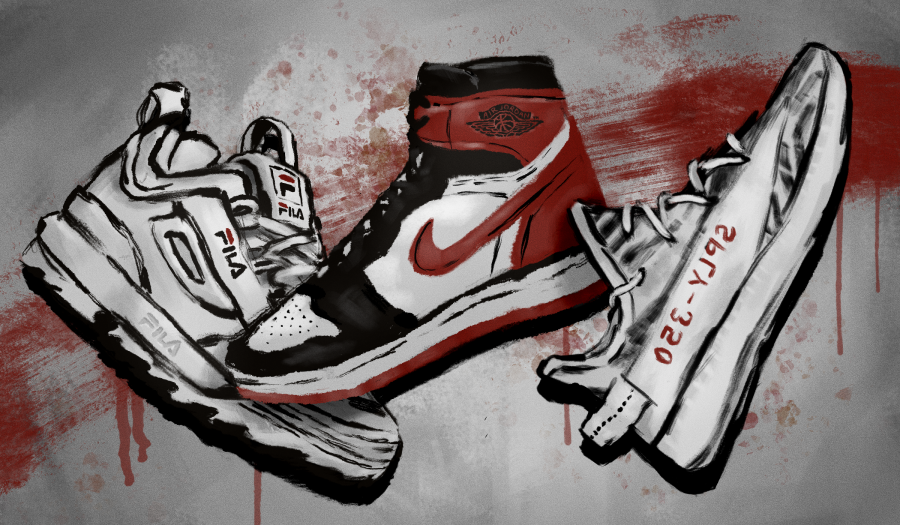Sneaker culture has become mainstream, and despite its association with hypebeasts and poor financial decisions, it was built from a deep appreciation for the art.
We lost many things with the transition from in-person to online classes: engaging participation, connections with classmates, and the ability to flex your shoes. A pristine pair of Jordans or Yeezys sell for hundreds if not thousands of dollars, but college students all over the country still wear them, subsequently making me feel bad for just wearing Vans to class.
The hobby of collecting expensive sneakers has grown from being a subculture to mainstream, and, in the process, the community has developed its own identity separate from the fashion community at large. Clearly, there’s something here that draws people in, so what makes these shoes so popular?
“I think it’s true that a lot of people just buy expensive shoes because they look cool,” Eleanor Roosevelt College senior Joshua Hoang said. “However, I also think that there are a lot of people who feel a deeper connection [with their shoes].”
For many “sneakerheads,” shoes aren’t just about how they look or feel. Every shoe has a story, something that people remember it by. Rather than an explanation, this is better understood with an example.
The year is 1989, and Michael Jordan has just made a jump shot, bringing the Chicago Bulls into a 99–98 lead against the Cleveland Cavaliers with only six seconds left on the clock. The setting: the Eastern Conference, a tournament for teams in the East to fight for positions in the NBA Playoffs. It’s an important game for the Bulls, and they are the underdog.
There wasn’t a doubt in any basketball fan’s mind that the Cavaliers were going to win. Before this game, the Bulls had lost all six of their games against the Cavaliers in the regular season. Going into the conference, the Cavaliers were seeded third and the Bulls were only sixth.
But now, Chicago had a chance to make an upset. They were able to grab the lead, and there were only six seconds left for the Cavaliers to bring it back. Shortly after Jordan’s shot the Cavaliers called a timeout. The ensuing play was made by Craig Ehlo and Larry Lance. When the game resumed, Ehlo passed the ball to Lance. A pass back immediately followed as Ehlo drove into the court. Sprinting through, Ehlo scored the layup, reclaiming a 100–99 point lead for the Cavaliers.
Bulls fans grew tense. Now it was Chicago’s turn to call a timeout; with only three seconds left on the clock, there would only be one last play in the game. This was Chicago’s last chance to pull off the upset and add to their legacy.
When the game resumed, Cleveland immediately sent Ehlo and Lance to double-team Jordan. Drifting right, Jordan faked out Lance. He quickly shifted left to catch the pass from Brad Sellers. Jordan ran to face the basket from the free-throw line. As the buzzer screeched for the end of the game, Jordan jumped and made the shot, winning the game for the Bulls 101–100. From then on, this moment was dubbed simply, “The Shot,” and famously, during “The Shot,” a crisp pair of Nike Air Jordan 4s were on Jordan’s feet.
From then on, when a kid in Chicago went to their neighborhood court in some 4s, they relived the moment when Michael Jordan hit that shot. By playing basketball in his shoes, fans felt closer to their hometown hero. And so, the Jordan 4s became more than just a shoe; it became a symbol of Chicago’s triumph over a giant.
This legendary shoe is celebrated through the story of “The Shot.” Today, much of the younger generation of sneaker fans were not there to experience the 1989 conference game live. However, whether they know it or not, they experience a piece of its legacy through that moment’s shoe.
“What draws me to sneakers … is the story each sneaker has and what it means both literally and culturally,” Luis Aguilar said. “This alone makes every sneaker a piece of art and demonstration.”
While they do look good on your feet, they derive more meaning from what they represent. It’s about what time period they’re from, who made them, and what story they have to tell. This deep appreciation for the product is what has allowed fans to become attached on a personal level, and it’s why they’re willing to splurge large amounts of money.
Today, most shoes become meaningful through their association with a well-known icon. Along with Michael Jordan, many prominent basketball players like Lebron James, Kobe Bryant, and James Harden have received their own shoe line. This business strategy has become a staple, and it was all started by Converse.
In 1917, Converse released a basketball shoe called the “Non-Skids.” Although they performed fine, basketball player Charles “Chuck” Taylor wanted to modify the shoes in order to improve their flexibility and ankle support. In 1921, these revisions were implemented, and the shoe was released under the familiar name, “Chuck-Taylor All-Stars.”
The success of Chuck Taylors is unprecedented. By the 50s, they became the standard among basketball players, and by the 60s, they had captured nearly 80 percent of the basketball shoe market.
And today, nearly a hundred years after they were released, the Chuck Taylors are still prevalent and shifted status from sports to a classic, casual shoe that can be seen in many students’ wardrobe.
Since Converse, different player-branded basketball shoes have experienced a rise and fall in popularity such as AND1’s Tai Chi with Vince Carter and Pony’s Topstar with David Thompson. However, none have been as consistent as the aforementioned Nike Air Jordan. This brand has indisputably remained at the top of the sneaker game for the last 35 years. Every basketball apparel brand wants to have a line like the Jordans, one that develops a cult following and is always profitable.
In order to achieve this dream, corporations fought to sign the most successful players to imitate Jordan’s influencer business model, slowly standardizing this practice within the shoe industry and inadvertently laying the groundwork for what modern sneaker culture would become.
Since then, sneaker culture has slowly crept from a niche hobby to the mainstream, but there isn’t a single, identifiable reason for this.
A large part of the success was likely due to its close relation to hip-hop culture during its rise to prominence. In addition, it was also likely because luxury goods in general have gained popularity with the rise of social media. The marketing strategy for sneakers was also very ahead of its time, taking advantage of influencer marketing before the internet even existed.
Today, one of the most prominent examples of influencer marketing in this industry actually isn’t a basketball shoe, it’s Kanye West’s Yeezy line. The Yeezys are a unique fusion between a running and casual shoe, but ultimately, they aren’t the star of the show, Kanye is.
“When I think of Yeezys, I think of Kanye,” Hoang says. “I think he’s probably the reason why I got them.”
Kanye is a clear symbol of how much influencer association has propelled sneaker culture. This bizarre artist, who even ran for president, has the perfect persona for attention and virality. So when you think about Yeezys, you think about Kanye; they’re not just nice shoes, they’re Kanye’s shoes. This along with the now common practices of developing hype with a limited supply has brought this newcomer “toe-to-toe” with Jordans and the top of the sneaker hierarchy.
The practice of generating hype through artificial scarcity cannot be avoided when talking about modern sneaker culture. It’s one of the most prominent characteristics that non-sneakerheads associate with the culture. While stories may bring a community of people together to celebrate a memory, hype brings people together for a reason many critics would call superficial.
When thinking about hype culture, the image of a crowded line of broke college students waiting to make a poor financial decision comes to mind for many. The stories and icons associated with shoes were always ultimately the result of a business model, but hype culture has arguably furthered the presence of business in the community. Buying and reselling expensive shoes have become its own industry within the sneaker industry at large, a practice that not only draws a lot of attention but also a lot of criticism.
Those who fall into this negative stereotype are referred to as “hypebeasts,” but many dedicated sneakerheads distinguish themselves from this group, claiming that they hold an inherent interest in the product as opposed to a superficial attraction.
However, distinct boundaries are hard to draw, as there are simply too many different kinds of fans now that the culture has become mainstream. Even though sneakerheads consider hypebeasts to go against the spirit of sneaker culture, ultimately, they have become an inseparable part of it. The culture has evolved to have “superficial” fans, but this is a natural process for any culture that grows in popularity, and this may not be a bad thing.
“No matter which side one is on, I just want people to learn that there is much more to sneakers than just some color or price,” Aguilar said. “For many people, like me, it is also a piece that represents where I came from and my experiences in life, to where I am now.”
Art by Angela Liang for The UCSD Guardian.













